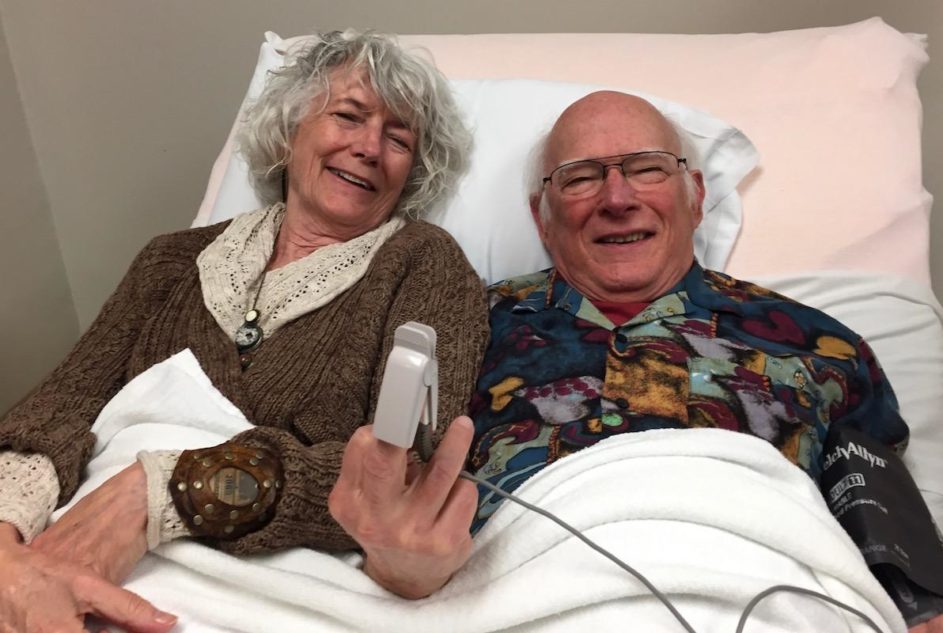When Dr. John Finger, former head of the University of Tennessee History Department, first got the diagnosis of early on-set Alzheimer’s disease, it was devastating to both him and his wife, fiber artist Judy Gaston.
For the next several months, doctor’s exams, lab tests, being swallowed up by the monsters of modern medicine’s sophisticated diagnostic machinery, and spending long, quiet hours together sorting through what it all might mean for their lives became their existence.
Finger spent the time he had under his control reading everything he could get his hands on and endlessly researching what new medical thinking might be out there.

Two-piece ensemble of pants and top woven from clinical fabric strips, with the top open in the back in the tradition of open-back hospital gowns and featuring a necklace of fabric strips, syringe covers, IV bag hangers and other paraphernalia.
Like artists through the centuries have always done, Gaston turned her thinking to making sense of what of was happening to them through her art. It was her illness, too, just as spouses and family members everywhere get absorbed into their loved ones’ illnesses.
Artists have always turned to their art when tragedy and devastation confront them.
Johann Sebastian Bach was an orphaned teenager in the care of his older brothers when one them, Johan Jacob, left to find work in Sweden in 1704. Bach dealt with feeling abandoned by composing his sad, moving “Capriccio on the Departure of a Beloved Brother,” BWV 992, his only surviving composition that had a specific storyline.
When German poet Freidrich Rückart lost two of his young children to scarlet fever within 16 days of each other in 1833, he responded by writing 425 poems collectively titled “Kindertotenlieder” (“Songs of the Death of Children”).
In 1907, Gustav Mahler dealt with his own loss by setting five of them to music after the death of his own daughter. The cycle of orchestral songs became his most intimate and personal musical expression.
In 1937, after German and Italian warplanes, at the request of Spanish nationalists, blew apart the town of Guernica, Spanish painter Pablo Picasso responded by painting his massive anti-war canvas titled after the destroyed town.
Following the death of her husband, John Dunne, in 2004, writer Joan Didion poured her pain and emotional loss into her book “The Year of Magical Thinking.”

A lovely skirt and jacket piece, woven from clinical fabric strips, utilizing New York Times wrappers as fringe and texture, with accents made from EKG tabs.
Gaston understood these artists’ feelings intimately. “You feel so helpless, like there’s nothing you can do,” she said.
When Finger found his way into a clinical study investigating new medical regimens of treating his particular type of Alzheimer’s, Gaston began to think there was a way she could respond.
“When JD was in the hospital, I spent every minute with him that I could,” she said. “I decided I’d ask for everything they would let me have: those awful hospital gowns that open in the back, wristbands, tubing, the EKG tabs they stick to your skin, syringes, latex gloves, absolutely everything they would allow me to keep.”
She cut the gowns and other fabric and paper materials into strips that she could weave into wearable garments. When she didn’t have the right materials from the hospital to get the kind of sculptural texture she wanted, Gaston added the blue plastic sleeves their New York Times came in. They blended well with the clinical materials.
“It meant everything to me to put my pain, grief and confusion into something that I could make sense of,” Gaston said.

“Meg’s Letter,” an ensemble composed of a pair of the paper shorts given to patients for exam procedures, topped with a jacket woven from hospital gowns cut into strips to make the weft of the fabric. Meg’s letter enclosed in a zip-lock back stitched to the back.
An important element came in the form of a letter written by Finger’s granddaughter, Meg.
Written in red crayon, it said “… and I hope that you will not be in the hospital for the next 15 years.”
“I thought it was so poignant and perfectly fitted a child’s sense of time. I had to incorporate it,” Gaston said. “Everyone’s sense of time gets warped in these situations.”
She put the page of the letter in a zippered plastic bag and stitched it to the back of one of the garments.
These remarkable garments, along with other of Gaston’s lovely woven wearable art, can be seen and purchased at her studio on the lower lever of The Emporium Center for Arts and Culture, at 100 S. Gay St. To visit, call 865-573-5908 to ensure she is in her studio or available for an appointment.

